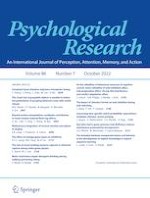Introduction
Eyewitness identifications have a prominent impact on police investigations and criminal proceedings. They can help resolve a case (Davis, Jensen, Burgette, & Burnett,
2014), but can also contribute to wrongful convictions (
http://www.innocenceproject.org; National Research Council,
2014). Meta-analyses show that the average decision accuracy for 6-person lineups revolves around 50% (e.g., Clark, Howell, & Davey,
2008; Fitzgerald & Price,
2015; Steblay, Dysart, & Wells,
2011). While proper lineup construction and administration can increase accuracy rates (e.g., Brewer & Palmer,
2010), scholars have recently voiced a need for alternative identification procedures (Brewer & Wells,
2011; Wells, Memon, & Penrod,
2006). Here, we will test the usefulness of one such potential alternative, namely the Concealed Information Test (CIT; Lykken,
1959; Verschuere, Ben-Shakhar, & Meijer,
2011).
The CIT assesses the recognition of information. In criminal cases, it does so by presenting suspects with multiple options related to a key feature of the crime (such as the weapon or location) and assessing their reactions to each option using physiological and behavioral measures (e.g., skin conductance, respiration line length, event related potentials, reaction times). The reaction time-based CIT (RT-CIT; Seymour, Seifert, Shafto, & Mosmann,
2000) commonly entails the sequential, rapid presentation of crime-related (i.e., probe) and unrelated (i.e., irrelevants) options on a computer. For instance, if a homicide is investigated in which the murder weapon used was a kitchen knife, stimuli in the RT-CIT may be a picture of the kitchen knife and of other possible murder weapons (e.g., a hammer, a baseball bat, a pistol, a switchblade). Examinees are required to respond to all items by pressing one of two buttons. To ensure that they process the stimuli, examinees respond with a dedicated button for a set of stimuli (called targets) memorized just before starting the CIT and with another button for all other stimuli. In the example above, the examinee may be asked to press one button for the target hammer, while pressing a different button for all the other stimuli. The core idea behind the RT-CIT is that only an individual with knowledge of the crime will respond differently to the crime-related stimuli (i.e., probes) as compared to the irrelevant stimuli.
The RT-CIT has been used in many experiments to assess the recognition of objects and verbal stimuli. A meta-analysis of 34 studies with 1063 participants in total reported a large RT-CIT effect (Cohen’s
d = 1.30; Suchotzki, Verschuere, Van Bockstaele, Ben-Shakhar, & Crombez,
2017). Its diagnostic value (expressed as area under the curve) has been found to be 0.82 (Meijer, Verschuere, Gamer, Merckelbach, & Ben-Shakhar,
2016). This means that there is an 82% probability that a person picked at random from those who recognize the stimulus (i.e., someone who possesses crime-related information) responds more distinctively than a person picked at random from those who do not recognize the stimulus (i.e., do not possess crime-related knowledge).
The RT-CIT is also capable of detecting face recognition in participants who thoroughly memorized previously unseen faces just prior to taking the CIT (Seymour & Kerlin,
2008). Furthermore, the RT-CIT has shown to be particularly useful for highly familiar (e.g., sibling) faces when participants concealed recognition (by pressing the ‘do not recognize’ button), but not for less familiar faces (e.g., teacher) when participants were revealing recognition (Meijer, Smulders, Merckelbach, & Wolf,
2007). This suggests that face familiarity, individually or in combination with intent to deceive may be critical for assessing face recognition in the RT-CIT.
Further exploring the usefulness of the CIT as an alternative identification procedure, Sauerland, Wolfs, Crans, and Verschuere (
2017) tested the utility of the RT-CIT in a typical eyewitness setup. Across five experiments, participants viewed a video of a mock crime before taking the RT-CIT. The pictures included in the CIT were carefully matched in terms of physical characteristics following the guidelines of explicit eyewitness identification procedures (Wells et al.,
1998). A mini meta-analysis across these five experiments revealed a negligibly small effect size of
d = 0.14. It is the aim of the current work to test two possible explanations for this unexpectedly small effect size. First, the physical similarity of the faces (i.e., matched faces) required in a fair lineup may have lowered the diagnosticity of the RT-CIT (Sauerland et al.,
2017). Note that the facial images used in previous studies (Meijer et al.,
2007; Seymour & Kerlin,
2008) were not similar according to physical characteristics (i.e., non-matched). If the RT-CIT is to meet eyewitness identification guidelines (Technical Working Group for Eyewitness Evidence,
1999; Wells et al.,
1998), the physical characteristics of the distractors should match those of the suspect (or of the perpetrator description) to minimize the possibility of a wrongful identification (Brewer & Palmer,
2010; Fitzgerald, Price, Oriet, & Charman,
2013). There is indeed evidence to suggest that the size of the CIT effect varies with the similarity between the probe and the irrelevant stimuli (Ben-Shakhar & Gati,
1987).
A second explanation for the limited usefulness of the RT-CIT as an identification procedure in Sauerland et al. (
2017) includes the possibility that the intent to deceive is critical for the RT-CIT to be beneficial (see Meijer et al.,
2007). Indeed, when instructing participants to either conceal or reveal their knowledge regarding an event, deception was found to be critical for a large RT-CIT effect to occur (Suchotzki, Verschuere, Peth, Crombez, & Gamer,
2015). Thus, the RT-CIT effect is not merely driven by recognition, but also by a response conflict and attempting response inhibition when deceiving (for further CIT studies manipulating cooperativeness see klein Selle, Verschuere, Kindt, Meijer, & Ben-Shakhar,
2015,
2017; Zvi, Nachson, & Elaad,
2012).
Publisher’s Note
Springer Nature remains neutral with regard to jurisdictional claims in published maps and institutional affiliations.
